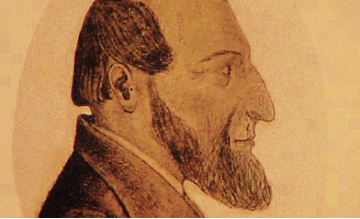Samuel H. Fröhlich und die «Neutäufer» - Samuel H. Fröhlich and the «New Anabaptists»
Founding figure of the New Anabaptist congregations ("Neutäufergemeinden")
Sometimes new ideas succeed in peacefully reshaping existing structures. Sometimes, however, painful ruptures seem to be the price to be paid for the emergence of something new. In church history, different convictions about the Bible and faith have repeatedly led to encouraging impulses and new departures. But they have also been the source of painful tensions and discord.

Samuel Heinrich Fröhlich (1803-1857), founder of the Evangelical Anabaptist congregations (Neutäufer), by Wikipaedia.
The history of Anabaptist churches in Switzerland is also aware of the opportunities and dangers of new beginnings. This is illustrated by the story of Samuel H. Fröhlich (1803-1857) and the "Neutäufer" movement, which is still present in the Emmental today. In addition to the ecclesiastical landscape, the latter has also helped shape economic life here over the past 200 years. The pioneering generation of the Kambly company in Trubschachen, for example, belonged to the Neutäufer community.
More Information:
Samuel Heinrich Fröhlich (1803-1857)
In the course of his theological studies in Zurich and Basel, Samuel H. Fröhlich experienced a severe crisis of faith. His encounter with contemporary rationalist theology triggered in him an existential struggle for truth. He found new support through his contacts with circles of the revivalist movement. In his first position as pastor in the Reformed Church of the Canton of Aargau, his revivalist preaching was very popular among many parishioners in Leutwil (1828-1830). But it also led to strong polarization and turned the church leadership against him.
After his dismissal (1830), he worked as a free preacher mainly in pietistic-awakening circles in Switzerland, southern Germany and Alsace. As a result of his criticism of infant baptism, he became increasingly alienated from the national churches and moved closer to Anabaptist-Mennonite positions. When he himself received baptism in the context of the Geneva Réveil in 1832, the break with the Reformed Church was complete.
Fröhlich now began an extensive church planting activity, which in the same year 1832 also led him to the Emmental to Langnau to the Anabaptist congregation there.[1] Here, too, his preaching triggered an ambivalent reaction: Some welcomed him as an impetus for spiritual renewal, while others rejected him as too brash and radical. In 1835 there was a break - the group henceforth called "Neutäufer" founded a new congregation in the hamlet of Giebel.[2]
Until Fröhlich's death in 1857, numerous new foundations were established in German-speaking Switzerland, French-speaking Switzerland, Alsace and southern Germany, and later in Eastern Europe and North America. Due to theological differences and intransigence, the relationship with the older Anabaptism as well as with other simultaneous church foundations of the revival movement (Baptists, Free Evangelical Churches, Chrischona, etc.) remained tense. Further narrowing led the "Neutäufer" after 1860 on the way to an increasingly "closed society". The result was a renewed split around 1900. The more open group developed back into an Evangelical Free Church in the course of the 20th century, which maintains contact with other national and free churches and today has about 3,000 members under the name "Evangelische Täufer-Gemeinde" (ETG) in Switzerland. The more closed group remained true to its approach until the present day and organizes its church life in a largely self-contained manner. Both groups are still present in Emmental today.[3]
[1] On the older Anabaptist congregation in Langnau, see the portrait of the elder there, Ulrich Steiner, in this exhibition in the "LOVE AND PRAISE" cell.
[2] For further details cf. Bernhard Ott, Neues Licht auf die Entstehung der "Neutäufer". The Separation of the New Anabaptists from the Old Anabaptists in the Emmental in the Light of the Written Records of Samuel Heinrich Fröhlich, in Mennonitica Helvetica 18 (1995), 69-90.
[3] On the history of the "Neutäufer" movement, see Bernhard Ott, Missionarische Gemeinde werden. Der Weg der Evangelischen Täufergemeinden, Uster (Verlag ETG) 1996. Further also Hanspeter Jecker / Bernhard Ott (eds.), Alt- und Neutäufer - Gemeinsame Vergangenheit!? Common Future ?! (Bienenberg Studienheft 1), Liestal (European Mennonite Bible School) 1993.



